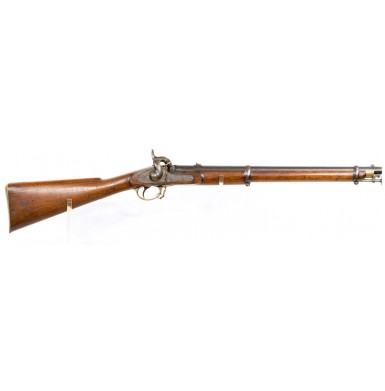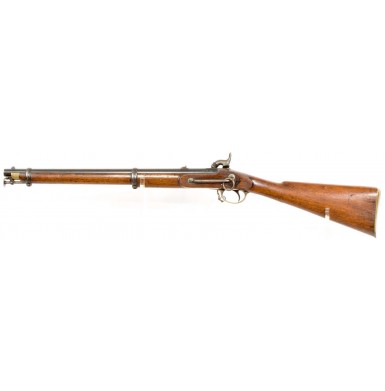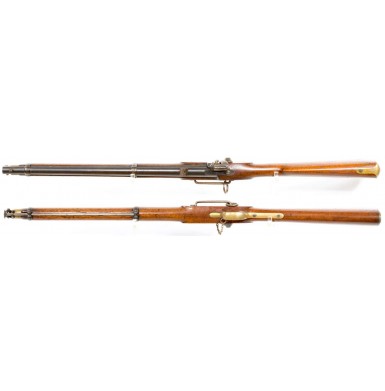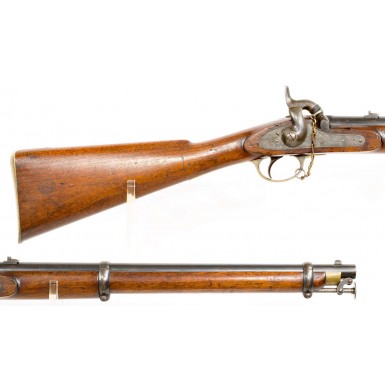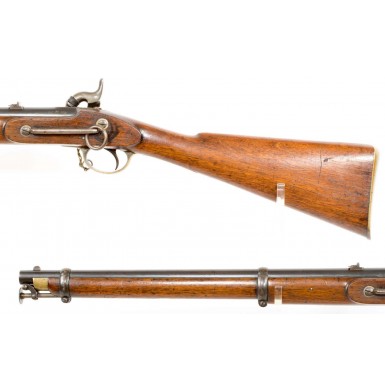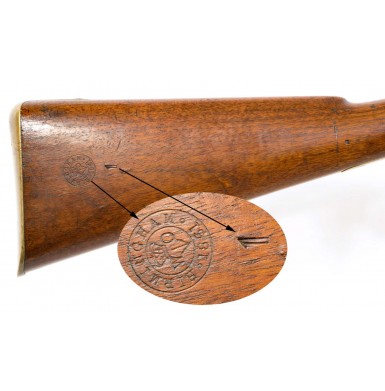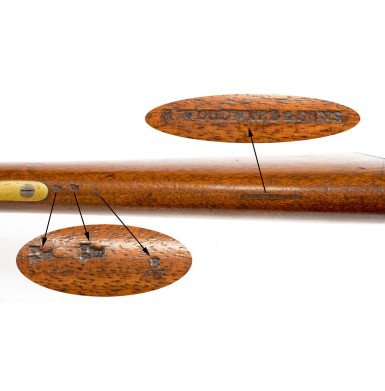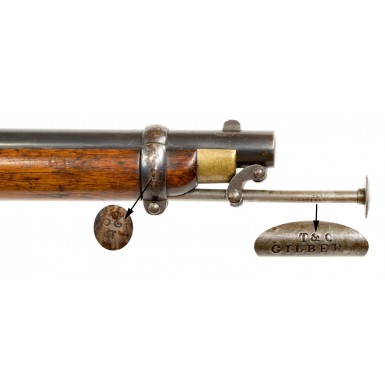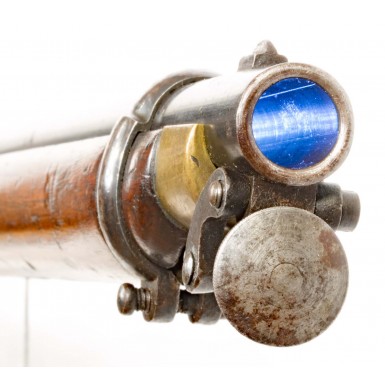British Military Pattern 1856 Cavalry Carbine - About Excellent
- Product Code: FLA-3569-SOLD
- Availability: Out Of Stock
-
$1.00
The best possible description of the British Pattern 1856 Cavalry Carbine is that it was a compromise; a carbine that no one wanted, and yet was the only logical solution to the current needs of the British military. The mid-19thcentury saw the British Board of Ordnance in a transitional phase, in fact the Board of Ordnance ceased to exist in 1855, being replaced by a section within the War Department. It is sometime around 1856 that we begin to see the changeover from the B (Broad Arrow) O Board of Ordnance storekeepers mark in the stocks of firearms, to the W (Broad Arrow) D War Department mark. This mark still conveyed the same information, that the gun was British military property, but was now marked by the War Department, rather than the Board of Ordnance. 1853 had seen the adoption of the Pattern 1853 “Enfield” Rifle Musket by the British military and had brought the most advanced muzzle loading, percussion ignition rifle musket of the period into use for all regular infantry regiments. An entire series of long arms would be spawned from the Pattern 1853, including the Pattern 1853 Artillery Carbine, the Pattern 1856 and Pattern 1858 (and eventually the Pattern 1860 and Pattern 1861) short rifles, and the Pattern 1856 cavalry carbine. The “Enfield” family of small arms was the first widespread adoption of a “reduced caliber” rifled long arm for a major world power. While the .577 bore of the Enfield does not appear to be “small” by today’s standards, it was somewhat revolutionary in concept for the period, as at the time most of the world’s powers still relied upon muskets and rifles that were nominally .69 to .71 caliber. The fact that the Enfield was rifled was revolutionary as well, as up until that time standard infantry doctrine called for rifled arms to only be issued to specialty troops and relied upon the smoothbore musket for the line infantry. Now, all British infantry would be issued rifled long arms.
During the early part of the 1850s, the British cavalry was armed with a variety of outdated and non-standard arms. The most widely issued was the Pattern 1844 Yeomanry Carbine, a .66 caliber smoothbore percussion weapon, and the next most common was the .66 smoothbore Pattern 1847 Padget Percussion Carbine, many of which were either converted from flint or made up from old flintlock parts, some of which still retained the Georgian era proof marks! Additionally, some Padget’s were rifled in an attempt to make them more modern, and several regiments serving in India, South Africa and Ireland used double-barreled carbines of various patterns that saw issue only to those regiments. None of the cavalry arms were standardized. Small arms standardization had been one of the goals of Board of Ordnance Inspector George Lovell, who had helped champion the modernization of British military small arms.
At the same time that the Pattern 1853 was revolutionizing the concept of the infantry musket, it was becoming clear that some form of breech loading rifled carbine was going to be the best choice to arm the cavalry. The problem was to decide which one. In 1855, a number of American made Sharps Model 1855 carbines were ordered for the British cavalry. These were delivered between May of 1856 and April of 1858, with a total of 6,000 of the guns seeing British service. All were issued to cavalry regiments serving in India. In 1855, another American design was ordered as well, the Greene Patent Carbine. Over the next 18 months or so, some 2,000 of these carbines were delivered to the British military as well, but these arms saw only trials issue and service, and no real use in combat. Domestic designs were considered as well, including the Calisher & Terry breechloading carbine, and eventually the Westley Richards “Monkey Tail” breechloading design. None of these arms provided the solution the British military was looking for. In almost all cases the primary issue was with the ammunition. In the case of the Greene and Sharps carbines, the problem was that combustible cartridges that were sturdy enough to withstand the rigors of field service tended to be too tough for the carbines to use and detonate effectively, while those that were easily cut open by the Sharps’ breech block or pierced by the Greene’s firing pin shaped flash channel tended to fall apart in the cartridge box during regular field service. The Terry Carbine had accuracy and durability issues with its patent ammunition as well. Other patterns and designs of breechloading were also tested in smaller numbers, but none proved to be the answer the British were searching for. The end result was that in 1856 the Pattern 1856 Cavalry Carbine was authorized, a gun essentially based upon the carbine in service with the East India Company at that time and was thus known in service as the East India Service Pattern. The gun was a compact, muzzle loading percussion firearm with a 21” barrel with the service standard .577” bore. The carbine closely resembled the P1853 Rifle Musket that it was patterned after, with a blued barrel and barrel bands, color case hardened lock and brass furniture. The ramrod was of the captive design, mounted to stud under the barrel, near the muzzle, with a pair of swiveling arms. The rear sight was of the same pattern used on the P1853 Artillery Carbine and consisted of a fixed 100-yard leaf and two additional folding leaves for 200 and 300 yards, respectively. The sight had been developed by Thomas Turner as part of the design of the P1853 rifle musket and had originally been intended for use in conjunction with an adjustable long ladder sight regulated out to 1,000 yards. This pattern of sight was never officially adopted for general issue with the P1853, but the 3-leaf portion used for 100, 200 and 300 yards did see use on the carbines until a new sight was adopted for cavalry and artillery carbines in 1861. The carbine was 37” in overall length, and included an iron sling bar opposite the lock, secured to the stock with iron side nail cups that also secured the lock mounting screws. Although the majority of the P1853 family of arms utilized progressive depth rifling, the majority of P1856 carbine production did not, although the standard 1:78” rate of twist was retained in the carbine bores. In the end, in an era where even the US military had discovered that breechloading carbines were the wave of the future, the British military settled upon an essentially obsolete design and kept it in use for a decade, when it was finally replaced by the Snider carbine, the British version of the American “Trapdoor” system, that altered percussion muzzle loaders to breech loading cartridge guns.
This example of a British Military Pattern 1856 Cavalry Carbine is in about VERY FINE to NEAR EXCELLENT condition. Were it not for some minor splintering and wood loss in the ramrod channel, it would rate fully “excellent”. The carbine is 100% complete and correct in all ways and shows the assembly mating mark of the Roman numeral \/ |or an Arabic 6 on nearly every major and minor component. The lock is crisply and clearly marked (CROWN) / VR to the rear of the hammer and 1861 / TOWER forward of the hammer. There is also a small British military (CROWN) / (BROAD ARROW)on the forward portion of the lock, below the bolster. The interior of the lock is marked B&WS over the mainspring and R&W ASTON in an arc around the mainspring boss. Numerous inspection marks are also present, inside the lock and on the reverse of the hammer neck. The top edge of the lock plate is marked with the mating mark 6. The breech of the carbine is marked with the usual British military proofs, and the bottom shows a myriad of marks and initials. The mark of the barrel maker EZRA MILLWARD is clearly stamped underneath, as are the initials of the contractor who made the carbine, BW for B. Woodward & Sons. Again, the usual myriad of crowned inspection marks are present under the barrel as well, along with the mating number 6 that appears on both breech plug and the barrel. While this assembly mating number usually refers only to the barrel and breech plug assembly, in case it is also the assembly number for the gun. As noted, a variation of the number “6” appears throughout the carbine, both as an Arabic and a Roman numeral, including the barrel bands, nose cap, breech tang screw and both lock mounting screws. The barrel channel of the stock is stamped BW1 as well as with inspector marks, and the stock flat opposite the lock is stamped BW20. Most makers had various workmen employed by them who were paid on the piece work system; thus, the workmen would include their initials on parts that they made or fit to the gun. In the case of B. Woodward & Sons, it appears the workmen were assigned a number as nearly all the major components have the initials “BW” followed by a number.
The obverse buttstock shows a British military storekeepers roundel cartouche, that reads BIRMINGHAM with the date 1861 around a (CROWN) / W O / (BROAD ARROW).While the “BO” for Board of Ordnance and the “WD” of War Department are frequently encountered on British military arms, occasionally I have noted the “WO” mark, which I assume might stand for “War Office”, possibly a transitional mark between the other two. Interestingly the other guns with the same type of cartouche that I have most recently encountered were Birmingham contract P1856 Cavalry Carbines. The stock is also marked with a 1 indicating the carbine was a “First Class” arm and could be issued to front line troops, rather than a lower quality gun held in reserve or for Yeomanry regiments, who typically received lesser quality arms. The belly of the stock is marked with several small inspection and markers marks behind the triggerguard, as well as with the maker name B. WOODWARD & SONS along the toe of the stock, between the triggerguard and the buttplate. Benjamin Woodward was a Gun and Pistol Maker, who established his business in 1838 at 260 Newtown Row in Birmingham. In 1840, he moved to 10 Whittall Street, and in 1842 became “B WOODWARD & SONS”, operating under that name until the firm ceased to exist in 1883.
As noted above, the overall condition of the carbine is about VERY FINE to NEAR EXCELLENT. The gun retains about 80%+ of its original blued finish on the exposed portions of the barrel, with even more lovely deep original blue concealed by the barrel bands and under the barrel, where it has been protected by the stock. The protected portion of the barrel retains about 90%+ of its original blued finish. The top of the barrel shows some evenly distributed light surface oxidation with some tiny flecks of oxidized roughness shot through the finish. There is also some minute pinpricking in the breech area, behind the rear sight, as well as scattered along its length towards the muzzle. As noted, the exposed portion of the barrel retains about 80%+ original blue, which has thinned and faded slightly, blending beautifully with a mostly smooth plum brown patina. This makes the gun appear to retain even more finish than it really does. The gun remains extremely crisp throughout, with clear markings, including the British military proofs on the upper left quadrant of the breech. The bore of the carbine rates about VERY FINE. It is mostly bright with some scattered flecks of darkened oxidation and retains very crisp rifling. The bore shows some frosting in the grooves and some very lightly scattered pitting along its length. The lock of the gun retains about 80%+ of its original color case hardened finish, which remains mostly vivid with some minor dulling and fading. The lock is mechanically excellent and functions perfectly on all positions. The original rear sight is present and complete, and the leaves fold up and down, as they should. They are still marked “200” and “300” on the 200 and 300 yard leaves. The original front sight is in place near the muzzle as well. The original sling bar and ring are present on the flat of the carbine, opposite the lock, and remain fully functional. The upper portion of the bar is stamped by the Birmingham small-work contractor T & C GILBERT. The firm of Thomas & Charles Gilbert produced a wide range of gun parts ranging from ramrods and barrel bands, to screws, gun tools and other small metal components. The swivel ramrod is in place in the channel under the barrel and is Gilbert marked as well. The rod works smoothly, exactly as it should. An original snap cap (nipple protector) is included with the gun. Interestingly the carbine was not made with the small stud forward of the triggerguard that snap cap was usually attached to, so a tiny hole was drilled in the forward portion of the triggerguard bow to secure the protective device. The stock is in about VERY FINE or slightly better condition overall and remains extremely crisp. The stock has never been sanded and retains very sharp lines and edges where it should. The stock does show the usual assortment of bumps, dings, rubs and minor blemishes from field use, handling, service and storage, but nothing significant or abusive. In fact, the only real wear to the stock is along the edges of the ramrod channel, where some of the wood has slivered and some small chips are missing. This is not uncommon for any carbine that saw actual use. There is also some very minor wood chipping around the forward tang of the triggerguard. The stock is full-length and solid with no breaks or repairs noted.
Overall this is a really fantastic, 100% complete and correct example of a British Military Pattern 1856 Cavalry Carbine in a very high state of preservation. The gun has lots of eye appeal and is a really wonderful, high condition example with lots of original finish. The gun has lots going for it, in that none of the usual broken or missing parts like the sights and rammer are broken or missing. The gun shows real light use as well as some light firing wear, but still retains a really fine bore. Although potentially a little too nice for the firing line, it would no doubt be a an extremely accurate candidate for a shooting example of these compact rifled carbines. In addition to the large amounts of remaining finish and fine bore, the gun is mechanically excellent. This carbine would be a very fantastic addition to any collection of Enfield pattern arms or mid-19thcentury military carbines and would be rather difficult to upgrade.
SOLD
Tags: British, Military, Pattern, 1856, Cavalry, Carbine, About, Excellent


